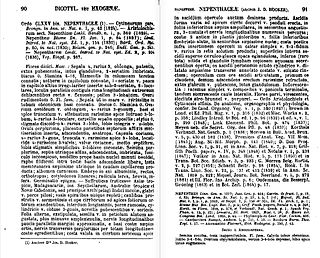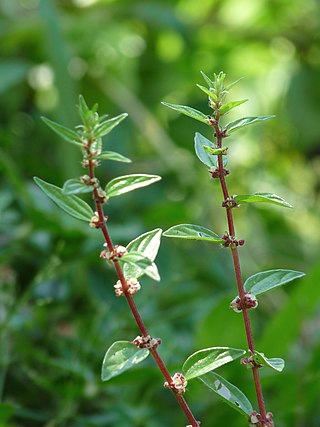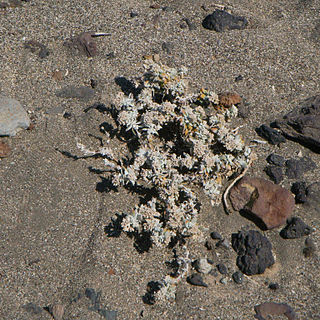
Bolinus brandaris, and commonly known as the purple dye murex or the spiny dye-murex, is a species of medium-sized predatory sea snail, an edible marine gastropod mollusk in the family Muricidae, the murex snails or the rock snails.

Banksia nivea, commonly known as honeypot dryandra, is a species of rounded shrub that is endemic to Western Australia. The Noongar peoples know the plant as bulgalla. It has linear, pinnatipartite leaves with triangular lobes, heads of cream-coloured and orange or red flowers and glabrous, egg-shaped follicles.

Alex George's taxonomic arrangement of Dryandra was the first modern-day arrangement of that taxon. First published in Nuytsia in 1996, it superseded the arrangement of George Bentham, which had stood for over a hundred years; it would later form the basis for George's 1999 treatment of Dryandra for the Flora of Australia. In accordance with contemporary thinking, George treated Dryandra as a genus, dividing it into three subgenera, the largest of which was divided into 24 series. The arrangement stood until 2007, when Dryandra was transferred into Banksia as B. ser. Dryandra. No alternative has yet been proposed.
Carl Meissner's taxonomic arrangement of Dryandra, now Banksia ser. Dryandra, was published in 1856 as part of his chapter on the Proteaceae in A. P. de Candolle's Prodromus systematis naturalis regni vegetabilis. It replaced the 1830 arrangement of Robert Brown, and remained current until superseded by the 1870 arrangement of George Bentham.

Utricularia caerulea, the blue bladderwort, is a very small to medium-sized carnivorous plant that belongs to the genus Utricularia. U. caerulea spans a wide native range, including areas in tropical Africa, Asia, and Australia. It grows as a terrestrial plant in wet, shallow soils over rock, in wet grasslands, in swamps, or near streams in open communities, mostly at lower altitudes but ascending to as much as 2,100 m (6,890 ft). It was originally described and published by Carl Linnaeus in 1753.

Dryandra subg. Dryandra is an obsolete clade of plant. It was a series within the former genus Dryandra. The name was first published at sectional rank as Dryandra verae in 1830, before being renamed Eudryandra in 1847, the replaced by the autonym at subgenus rank in 1996. It was ultimately discarded in 2007 when Austin Mast and Kevin Thiele sunk Dryandra into Banksia.

Prostanthera nivea, commonly known as snowy mint-bush, is a species of flowering plant in the family Lamiaceae and is endemic to eastern Australia. It is a shrub with linear to cylindrical leaves and white flowers arranged in leaf axils near the ends of branchlets and is one of the mint-bushes that is not aromatic.

"Nepenthaceae" is a monograph by Joseph Dalton Hooker on the tropical pitcher plants of the genus Nepenthes. It was published in 1873 in the seventeenth and final volume of Augustin Pyramus de Candolle's Prodromus Systematis Naturalis Regni Vegetabilis, which was edited by Augustin's son, Alphonse. The monograph focused primarily on new discoveries from northern Borneo. Unlike most major works on Nepenthes, it included no illustrations.

Pouzolzia is a genus of flowering plants in the nettle family. There are about 35 species distributed throughout the tropical world. Most are shrubs, and some are herbs. The genus was named for French botanist and plant collector Pierre Marie Casimir de Pouzolz (1785–1858).

Argyrochosma nivea is an Andean fern species in the family Pteridaceae.

Lamiini is a tribe of longhorn beetles of the subfamily Lamiinae.

Deliathis is a genus of flat-faced longhorns in the beetle family Cerambycidae. There are about 15 described species in Deliathis, found in the Neotropics.

Oncideres is a genus of longhorn beetles of the subfamily Lamiinae, containing more than 120 species in the nearctic and neotropics.
Deliathis buquetii is a species of beetle in the family Cerambycidae. It was described by Tasté in 1841, originally under the genus Taeniotes. It is known from Honduras, Belize, and Mexico. It contains the varietas Deliathis buquetii var. mira.

Deliathis impluviata is a species of beetle in the family Cerambycidae. It was described by Lacordaire in 1869. It is known from Mexico and Guatemala.
Deliathis neonivea is a species of beetle in the family Cerambycidae. It was described by Stephan von Breuning in 1943, but the original name is a junior homonym of Deliathis nivea so its name was replaced in 2018. It is known from Mexico.

Paraglenea fortunei is a species of beetle in the family Cerambycidae. It was described by Saunders in 1853, originally under the genus Glenea. It is known from Taiwan, China, North Korea, South Korea, and Vietnam, and has been introduced into Japan. It feeds on Cinnamomum camphora, Boehmeria nivea, Hibiscus syriacus, Morus alba, and Triadica sebifera.

Polycarpaea nivea is a species of flowering plants in the family Caryophyllaceae. The species was described by William Aiton in 1828 as Achyranthes nivea, and it was placed in the genus Polycarpaea by Philip Barker Webb in 1849. The specific name nivea is Latin for "white as snow", and refers to the colour of the plant.















